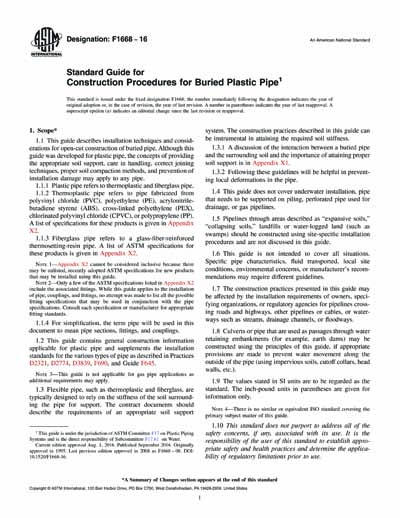Historical
ASTM F1668-16
Standard Guide for Construction Procedures for Buried Plastic Pipe
1.1 This guide describes installation techniques and considerations for open-cut construction of buried pipe. Although this guide was developed for plastic pipe, the concepts of providing the appropriate soil support, care in handling, correct joining techniques, proper soil compaction methods, and prevention of installation damage may apply to any pipe.
1.2 This guide contains general construction information applicable for plastic pipe and supplements the installation standards for the various types of pipe as described in Practices D2321, D2774, D3839, F690, and Guide F645.
1.3 Flexible pipe, such as thermoplastic and fiberglass, are typically designed to rely on the stiffness of the soil surrounding the pipe for support. The contract documents should describe the requirements of an appropriate soil support system. The construction practices described in this guide can be instrumental in attaining the required soil stiffness.
1.4 This guide does not cover underwater installation, pipe that needs to be supported on piling, perforated pipe used for drainage, or gas pipelines.
1.5 Pipelines through areas described as “expansive soils,” “collapsing soils,” landfills or water-logged land (such as swamps) should be constructed using site-specific installation procedures and are not discussed in this guide.
1.6 This guide is not intended to cover all situations. Specific pipe characteristics, fluid transported, local site conditions, environmental concerns, or manufacturer's recommendations may require different guidelines.
1.7 The construction practices presented in this guide may be affected by the installation requirements of owners, specifying organizations, or regulatory agencies for pipelines crossing roads and highways, other pipelines or cables, or waterways such as streams, drainage channels, or floodways.
1.8 Culverts or pipe that are used as passages through water retaining embankments (for example, earth dams) may be constructed using the principles of this guide, if appropriate provisions are made to prevent water movement along the outside of the pipe (using impervious soils, cutoff collars, head walls, etc.).
1.9 The values stated in SI units are to be regarded as the standard. The inch-pound units in parentheses are given for information only.
Note 4: There is no similar or equivalent ISO standard covering the primary subject matter of this guide.
1.10 This standard does not purport to address all of the safety concerns, if any, associated with its use. It is the responsibility of the user of this standard to establish appropriate safety and health practices and determine the applicability of regulatory limitations prior to use.
ASTM International [astm]

